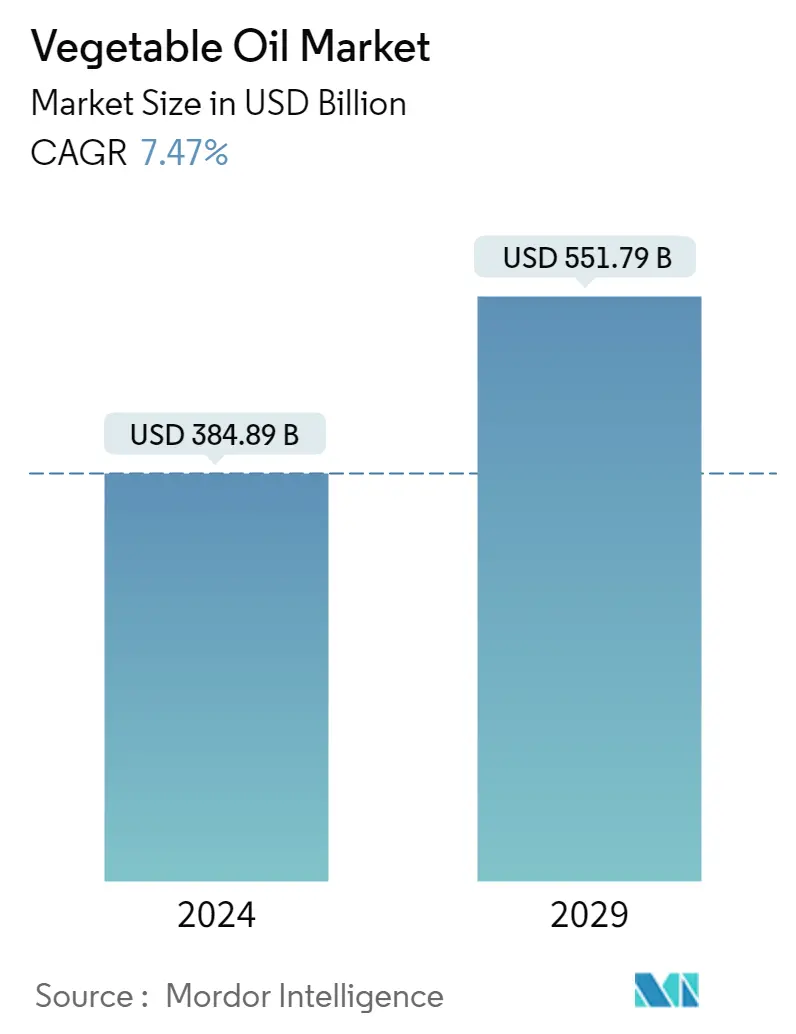Market Size of Vegetable Oil Industry

| Study Period | 2018 - 2029 |
| Market Size (2024) | USD 384.89 Billion |
| Market Size (2029) | USD 551.79 Billion |
| CAGR (2024 - 2029) | 7.47 % |
| Fastest Growing Market | Asia Pacific |
| Largest Market | Asia Pacific |
| Market Concentration | Low |
Major Players
*Disclaimer: Major Players sorted in no particular order |
Vegetable Oil Market Analysis
The Vegetable Oil Market size is estimated at USD 384.89 billion in 2024, and is expected to reach USD 551.79 billion by 2029, growing at a CAGR of 7.47% during the forecast period (2024-2029).
Russia and Ukraine's war has pushed the prices of vegetable oils to an all-time high. The Black Sea countries are significant exporters of sunflower oil. Thus, this war problem has caused vegetable oil prices to rise sharply and has also prompted trade policy reactions globally that further restricted supplies and drive-up expenses. According to the international food policy research institute, with a 40% increase since the day of the invasion, sunflower oil has been most immediately impacted,
Over the short term, the industry is expected to be driven by people's growing awareness of the health benefits of consuming vegetable oils, such as controlling heart health. The monounsaturated fats in foods like olive oil, canola oil, sunflower oil, hazelnut oil, and almond oil are proven to raise good cholesterol levels and minimize the risk of heart and cardiovascular disorders. Vegetable oils are currently in high demand since they create fuels, dishwashers, and perfume compositions. This is one of the main driving forces for the market's expansion. For instance, according to USDA Foreign Agricultural Service, the volume of used cooking oil used as a feedstock for biodiesel fuel production in India in 2021 was 55,000 metric tons, increasing from 50,000 metric tons in 2020.
In addition, there is a significant rise in the need for vegetable oils as an alternative to mineral oil across different end-use industries. Vegetable isolating oils are now commercially available to replace mineral-based oils in transformer applications. Vegetable oil may be a perfect replacement for mineral oil because of its inexpensive cost, reduced volatility, improved performance under pressure, high viscosity, and widespread accessibility. Leading industry competitors are now offering vegetable oil varieties that have undergone little processing and are organic. This is encouraging the market's expansion, coupled with numerous programs launched by governing bodies of various nations to promote bio-based goods like vegetable oils.
Vegetable Oil Industry Segmentation
Vegetable oils are extracted from seeds or, less often, from other parts of fruits. Similar to animal fats, vegetable oils are also mixtures of triglycerides. The global vegetable oil market has been segmented by type, application, and geography. By type, the market studied is segmented into palm oil, soybean oil, rapeseed oil, sunflower oil, olive oil, and other classes. The market is segmented based on application: food, feed, and industrial. The study also involves the global-level analysis of the central regions such as North America, Europe, Asia-Pacific, South America, and the Middle East & Africa. For each segment, the market sizing and forecasts have been done based on value (in USD million).
| By Type | |
| Palm Oil | |
| Soybean Oil | |
| Rapeseed Oil | |
| Sunflower Oil | |
| Olive Oil | |
| Other Types |
| By Application | |
| Food | |
| Feed | |
| Industrial |
| Geography | |||||||||
| |||||||||
| |||||||||
| |||||||||
| |||||||||
|
Vegetable Oil Market Size Summary
The vegetable oil market is poised for significant growth, driven by increasing consumer awareness of the health benefits associated with vegetable oils, such as olive, canola, and sunflower oils. These oils are known for their monounsaturated fats, which can enhance good cholesterol levels and reduce the risk of cardiovascular diseases. The market is also experiencing heightened demand due to the use of vegetable oils in various industries, including biofuels, where used cooking oil serves as a feedstock for biodiesel production. The ongoing geopolitical tensions, particularly the conflict between Russia and Ukraine, have led to a surge in vegetable oil prices, especially sunflower oil, due to supply chain disruptions and trade policy reactions. This has further fueled the market's expansion as countries seek alternative sources and strategies to secure their oil supplies.
In addition to health benefits, the market is witnessing a shift towards vegetable oils as substitutes for mineral oils in industrial applications, such as transformers, due to their cost-effectiveness and superior performance characteristics. The fortification of cooking oils with essential vitamins A and D is gaining traction, supported by government initiatives aimed at addressing micronutrient deficiencies and improving public health. Major players in the industry, including Wilmar International, Archer Daniels Midland Company, and Bunge Limited, are actively engaging in product innovations, strategic partnerships, and expansions to strengthen their market presence. The Asia-Pacific region, particularly China and India, is a dominant force in the vegetable oil market, with significant consumption and production activities. These developments, coupled with strategic investments and initiatives to boost domestic oilseed production, are expected to drive the market's growth trajectory in the coming years.
Vegetable Oil Market Size - Table of Contents
-
1. MARKET DYNAMICS
-
1.1 Market Drivers
-
1.2 Market Restraints
-
1.3 Porter's Five Forces Analysis
-
1.3.1 Threat of New Entrants
-
1.3.2 Bargaining Power of Buyers/Consumers
-
1.3.3 Bargaining Power of Suppliers
-
1.3.4 Threat of Substitute Products
-
1.3.5 Intensity of Competitive Rivalry
-
-
-
2. MARKET SEGMENTATION
-
2.1 By Type
-
2.1.1 Palm Oil
-
2.1.2 Soybean Oil
-
2.1.3 Rapeseed Oil
-
2.1.4 Sunflower Oil
-
2.1.5 Olive Oil
-
2.1.6 Other Types
-
-
2.2 By Application
-
2.2.1 Food
-
2.2.2 Feed
-
2.2.3 Industrial
-
-
2.3 Geography
-
2.3.1 North America
-
2.3.1.1 United States
-
2.3.1.2 Canada
-
2.3.1.3 Mexico
-
2.3.1.4 Rest of North America
-
-
2.3.2 Europe
-
2.3.2.1 United Kingdom
-
2.3.2.2 Germany
-
2.3.2.3 Spain
-
2.3.2.4 France
-
2.3.2.5 Italy
-
2.3.2.6 Russia
-
2.3.2.7 Rest of Europe
-
-
2.3.3 Asia-Pacific
-
2.3.3.1 China
-
2.3.3.2 Japan
-
2.3.3.3 India
-
2.3.3.4 Australia
-
2.3.3.5 Rest of Asia-Pacific
-
-
2.3.4 South America
-
2.3.4.1 Brazil
-
2.3.4.2 Argentina
-
2.3.4.3 Rest of South America
-
-
2.3.5 Middle East & Africa
-
2.3.5.1 United Arab Emirates
-
2.3.5.2 South Africa
-
2.3.5.3 Rest of Middle East & Africa
-
-
-
Vegetable Oil Market Size FAQs
How big is the Vegetable Oil Market?
The Vegetable Oil Market size is expected to reach USD 384.89 billion in 2024 and grow at a CAGR of 7.47% to reach USD 551.79 billion by 2029.
What is the current Vegetable Oil Market size?
In 2024, the Vegetable Oil Market size is expected to reach USD 384.89 billion.

